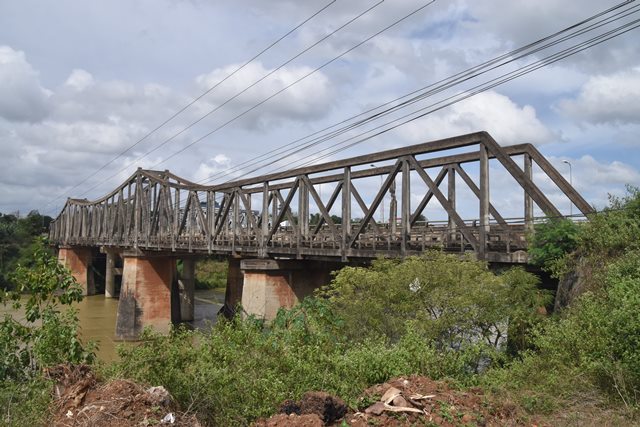We Recommend:
Bach Steel - Experts at historic truss bridge restoration.
Cầu Sêrêpốk (Srepok Bridge)
Concrete Bridge

Primary Photographer(s): Nathan Holth
Bridge Documented: December 8, 2018
Nguyễn Tất Thành (AH17, QL 14) Over Srepok River (Sông Serepôk) (sông Đăk Krông)
Buôn Ma Thuột: Đắk Nông Province (Tỉnh Đắk Nông) and Đắk Lắk Province (Tỉnh Đắk Lắk): Vietnam (Việt Nam)
Not Available or Not Applicable
190.0 Feet (57.9 Meters)
500.0 Feet (152.4 Meters)
9 Feet (2.74 Meters)
4 Main Span(s)
Not Applicable

View Information About HSR Ratings
Bridge Documentation
Cầu Sêrêpôk refers to what is today three bridges. Two bridges carry traffic today: a historic steel truss bridge carries westbound traffic, while immediately to the south, a modern bridge carries eastbound traffic. Immediately south of these two bridges is the third bridge, which is the original bridge here, which is today closed to traffic but left standing presumably for its heritage value. This page discusses this closed bridge.
Very little is known about this bridge and its history. Reportedly, this bridge was built by the French government in 1941. The bridge lengths and widths given are rough estimates. The bridge has a very narrow roadway. This concrete truss bridge has the shape and appearance of a cantilever truss bridge, but it is perhaps better described as a continuous truss bridge. The bridge span layout is asymmetrical, because instead of the three main spans typically found with continuous/cantilever bridges, there is an additional span that is part of the single continuous truss unit located at the east end of the bridge. This extra eastern span has parallel top and bottom chords, meaning the slope of the top chord seen in the other spans levels off before the easternmost span.
Concrete truss bridges are one of the most rare bridge types in the world. Concrete simply never became a popular material for constructing truss bridges. Continuous and/or cantilever concrete truss bridges are an even more rare subcategory of concrete truss bridge. There are at least three bridges of this type that have been built in Vietnam. One was destroyed with some remnants surviving today. Another, Cầu Cai Lậy, crosses the Ba Rai River in Tien Giang province. Unidentified historical photos further suggest there was at least one more bridge in addition to these three, and it is quite likely there may be more unaccounted examples, which may or may not survive today. Although all three bridges noted above are rare examples of continuous concrete truss bridges, the exact design details of each of these bridges varies, meaning these were not a "standard" bridge design in Vietnam. In any case, each surviving bridge is a rare and highly significant historic bridge, a bridge type that many countries do not have a single example of.
The abandoned bridge has severe deterioration in some members, and some members are actually broken. Despite this, the overall bridge remains standing, and aside from the deterioration, the bridge appears to be unaltered from its original design and retains its original material.
![]()
Photo Galleries and Videos: Cầu Sêrêpốk (Srepok Bridge)
Bridge Photo-Documentation
Original / Full Size PhotosA collection of overview and detail photos. This gallery offers photos in the highest available resolution and file size in a touch-friendly popup viewer.
Alternatively, Browse Without Using Viewer
![]()
Bridge Photo-Documentation
Mobile Optimized PhotosA collection of overview and detail photos. This gallery features data-friendly, fast-loading photos in a touch-friendly popup viewer.
Alternatively, Browse Without Using Viewer
![]()
Maps and Links: Cầu Sêrêpốk (Srepok Bridge)
Coordinates (Latitude, Longitude):
Search For Additional Bridge Listings:
Additional Maps:
Google Streetview (If Available)
GeoHack (Additional Links and Coordinates)
Apple Maps (Via DuckDuckGo Search)
Apple Maps (Apple devices only)
Android: Open Location In Your Map or GPS App
Flickr Gallery (Find Nearby Photos)
Wikimedia Commons (Find Nearby Photos)
Directions Via Sygic For Android
Directions Via Sygic For iOS and Android Dolphin Browser

